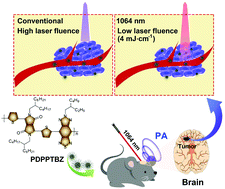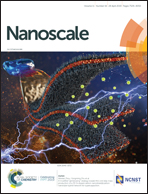A 1064 nm excitable semiconducting polymer nanoparticle for photoacoustic imaging of gliomas†
Abstract
Photoacoustic (PA) imaging in the second near-infrared (NIR-II) window (especially at 1064 nm) has the benefits of low background signal, high spatial resolution and deep tissue penetration. Here we report a semiconducting polymer nanoparticle (PDPPTBZ NP) and demonstrate its potential as a contrast agent for PA imaging of orthotopic brain tumors, using a 1064 nm pulsed laser as a light source. PDPPTBZ NPs have maximum absorption at 1064 nm with a mass extinction coefficient of 43 mL mg−1 cm−1, which is the highest value reported so far in this region. The high photothermal conversion efficiency (67%) and near non-fluorescence impart PDPPTBZ NPs with excellent PA properties. We used PDPPTBZ NP-containing agar gel phantoms even at a low concentration (50 μg mL−1) to successfully image to a depth of 4 cm (of chicken-breast tissue), with an ultralow power fluence (4 mJ cm−2). Furthermore, we could clearly visualize a glioma tumor in a mouse at a depth of 3.8 mm below the skull. This study demonstrates that PDPPTBZ NPs display great potential as a NIR-II PA contrast agent for high quality deep tissue imaging.



 Please wait while we load your content...
Please wait while we load your content...